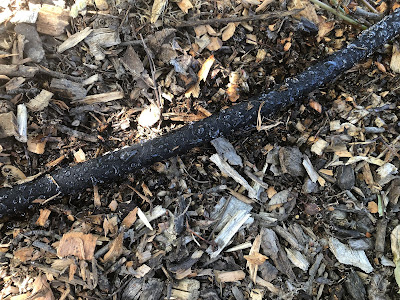
Since Jan. 1, Sacramento has received only 2 inches --10.6 below average

|
|
A soaker hose can deliver a long, slow drink of
water to precious trees and shrubs. Mulch helps
keep the moisture from evaporating too quickly. If possible, position the hose under the mulch for a better soak.
(Photo: Kathy Morrison)
|
How dry are we? Our lack of rain is taking on historical proportions.
According to the National Weather Service, Sacramento has recorded its driest first five months in 128 years. That’s how long the weather service has been keeping track of our rain totals.
And so far in 2022, those totals have been mighty bleak. Since Jan. 1, downtown Sacramento has recorded just over 2 inches – 2.01 – in total precipitation, says the weather service. That includes 0.06 for all of May. Normal for May: 0.84 inches.
Rain totals for March (0.94) and April (0.96) were less than 1 inch for each month. That followed a rainless February and a nearly dry January (0.05).
Sacramento’s normal rainfall total for the first five months: 12.6 inches. That’s almost a 10.6-inch shortfall. (And yes, that means we are in a drought – again.)
Don’t expect much June precipitation to add to those totals. Sacramento’s June rainfall averages 0.21 inches – or one good summer cloudburst. According to the weather service, there’s a 25% chance of showers Sunday, June 5, but it will only be a drizzle (if it materializes) – 0.03 inches.
That lack of good soaking rain can mean rock-hard soil – particularly in areas without regular irrigation. Without a source of moisture, roots of trees and shrubs tend to die back, weakening the plant and causing instability.
To save your landscape, deep-water trees and shrubs. Give them a long, slow drink with a soaker hose.
Lack of moisture also increases fire danger. Grasses and other vegetation in unirrigated pastures and wilderness areas have already dried out and browned to a crisp. One spark can start a wildfire.
In breezy conditions (such as this week), avoid mowing dry grass or using power tools that may strike a rock and spark.
May also continued a trend of warmer than usual weather. Daily highs averaged 83.6 degrees, 2.4 above normal.
What can we expect in June? Besides mostly dry days, June averages highs of 87 degrees and lows of 56. But triple digits are not uncommon. The hottest June day on record in Sacramento: 115 degrees.
For more on Sacramento weather: https://www.weather.gov/sto/#
Comments
0 comments have been posted.Sacramento Digs Gardening to your inbox.
Sites We Like
Garden Checklist for week of July 21
Your garden needs you!
* Keep your vegetable garden watered, mulched and weeded. Water before 8 a.m. to reduce the chance of fungal infection and to conserve moisture.
* Feed vegetable plants bone meal, rock phosphate or other fertilizers high in phosphate to stimulate more blooms and fruiting. (But wait until daily high temperatures drop out of the 100s.)
* Don’t let tomatoes wilt or dry out completely. Give tomatoes a deep watering two to three times a week.
* Harvest vegetables promptly to encourage plants to produce more. Squash especially tends to grow rapidly in hot weather. Keep an eye on zucchini.
* Pinch back chrysanthemums for bushy plants and more flowers in September.
* Remove spent flowers from roses, daylilies and other bloomers as they finish flowering.
* Pinch off blooms from basil so the plant will grow more leaves.
* Cut back lavender after flowering to promote a second bloom.
* It's not too late to add a splash of color. Plant petunias, snapdragons, zinnias and marigolds.
* From seed, plant corn, pumpkins, radishes, winter squash and sunflowers.